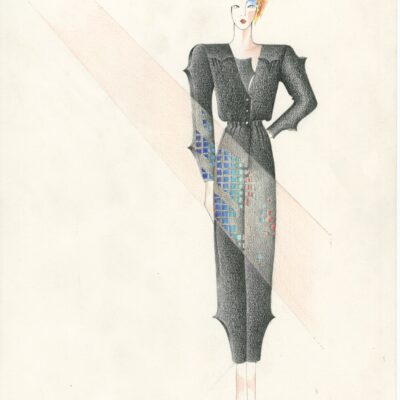
Designers 06.09.2022
06.06.2018
artItalian fashionItalian stylePalazzo Pitti
One of the first women of Italian Style
Maria Monaci Gallenga is a pivotal figure in the history of fashion, since she contributed to the acquisition, for the discipline and production of fashion, of autonomous value and dignity with respect to the artistic product.
Maria Monaci Gallenga was the daughter of Ernesto Monaci, professor of philology at the University of Rome La Sapienza, and during her youth she was surrounded by well-known personalities from the literary and artistic world of the time. Her career in design started in the 1910s: in those years she exhibited her creations, which included objects of furniture, cushions and panels with drawings printed with a new texcnique she invented, in many public events: the exhibition of the Roman Secession, the Panama-Pacific Exposition in San Francisco, the California exhibition. Demonstrating strong entrepreneurial skills, she was able to organise the flow of work in her atelier and transform it into a company able to produce big numbers and supply also the American market, whose costumers were fascinated by her innovative experimentations with printing and design.
She also worked with Vittorio Zecchin, with whom he took part in the Amsterdam and Paris exhibitions in the 1920s. She also collaborated with Antonio Maraini and Marcello Piacentini. She was also part of the National Agency for Crafts and Small Industry, founded in 1925 to promote the image of Italian products in the world. After the participation in the International Exhibition of Decorative Arts, held in Paris, in 1928 she opened the ‘Boutique Italienne’ together with Bice Pittoni and Carla Visconti di Modrone, a permanent showcase of the best products of Italian art.
In 1934 she left France to return to Rome, where her shop still was an active laboratory of ideas of artists working in different sectors. She retired from the business in 1938, leaving his son to run the Via Veneto store, which specialized in interior design.
The fame of Maria Monaci Gallenga is linked to the invention of a particular technique of printing , which consisted in the use of wooden matrices on which a glue was applied before being pressed onto the fabric, on which was then distributed a powder of metallic pigments in gold and silver. This way, one colour blended into the other, obtaining an effect that made the fabric look hand-painted rather than printed. As source of inspiration, Gallenga used both motifs from contemporaneous artists as well as ancient models. Her way of treating the ancient motifs was so original and modern, she used to study their structure and ‘break it’ into singular details and simpler groups.
Maria Monaci Gallenga is a pivotal figure in the history of fashion, since she contributed to the acquisition, for the discipline and production of fashion, of autonomous value and dignity with respect to the artistic product.
Maria Monaci Gallenga was the daughter of Ernesto Monaci, professor of philology at the University of Rome La Sapienza, and during her youth she was surrounded by well-known personalities from the literary and artistic world of the time. Her career in design started in the 1910s: in those years she exhibited her creations, which included objects of furniture, cushions and panels with drawings printed with a new texcnique she invented, in many public events: the exhibition of the Roman Secession, the Panama-Pacific Exposition in San Francisco, the California exhibition. Demonstrating strong entrepreneurial skills, she was able to organise the flow of work in her atelier and transform it into a company able to produce big numbers and supply also the American market, whose costumers were fascinated by her innovative experimentations with printing and design.
She also worked with Vittorio Zecchin, with whom he took part in the Amsterdam and Paris exhibitions in the 1920s. She also collaborated with Antonio Maraini and Marcello Piacentini. She was also part of the National Agency for Crafts and Small Industry, founded in 1925 to promote the image of Italian products in the world. After the participation in the International Exhibition of Decorative Arts, held in Paris, in 1928 she opened the ‘Boutique Italienne’ together with Bice Pittoni and Carla Visconti di Modrone, a permanent showcase of the best products of Italian art.
In 1934 she left France to return to Rome, where her shop still was an active laboratory of ideas of artists working in different sectors. She retired from the business in 1938, leaving his son to run the Via Veneto store, which specialized in interior design.
The fame of Maria Monaci Gallenga is linked to the invention of a particular technique of printing , which consisted in the use of wooden matrices on which a glue was applied before being pressed onto the fabric, on which was then distributed a powder of metallic pigments in gold and silver. This way, one colour blended into the other, obtaining an effect that made the fabric look hand-painted rather than printed. As source of inspiration, Gallenga used both motifs from contemporaneous artists as well as ancient models. Her way of treating the ancient motifs was so original and modern, she used to study their structure and ‘break it’ into singular details and simpler groups.